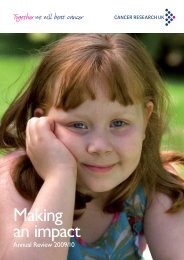Annual Review 2008/09 - Cancer Research UK
Annual Review 2008/09 - Cancer Research UK
Annual Review 2008/09 - Cancer Research UK
Create successful ePaper yourself
Turn your PDF publications into a flip-book with our unique Google optimized e-Paper software.
Working togetherto tackle skin cancer<strong>Research</strong>, information and influencing public policySarah LynessExecutive Director,Communicationsand InformationWe know how good it feels to be outside,enjoying the sunshine. People tell us they feelbetter when they have a suntan. And we knowthat sunlight is important for making enoughvitamin D. But spending too much time in thesun, or using sunbeds, can increase your riskof skin cancer. Skin cancer is one of the mostcommon cancers in the <strong>UK</strong> and more than2,600 people die from it each year in the <strong>UK</strong>.There are two main types of skin cancer. Non-melanoma skincancer is very common. Each year more than 81,000 cases ofnon-melanoma skin cancer are diagnosed in the <strong>UK</strong>, but almostall are treated successfully by local surgery. Melanoma is lesscommon but much more serious. The vast majority of deathsfrom skin cancer are from melanoma. More than 10,400people in the <strong>UK</strong> are diagnosed with melanoma each year.Survival rates for melanoma have been improving over thepast 25 years and are now among the highest for any cancer.This is thanks to a combination of improved awareness, earlydetection and better treatment.But there is still much to do. Over the last 25 years, thenumber of people developing melanoma in Britain has risenfaster than for any other common cancer. Experts believethat our love of sunbathing and our use of sunbeds arecontributing to these rising rates. So we will continue to workhard to beat this disease.Our researchLearning more about how skin cancer develops helpsresearchers design new ways to prevent and treat this disease.Our researchers are investigating how faults in specific genes,along with lifestyle factors, influence the risk of developingmelanoma. Understanding these lifestyle factors helps us giveclear advice on skin cancer prevention. We already know thatmost skin cancers are caused by overexposure to ultraviolet(UV) light from the sun or sunbeds.UV light affects our DNA and can lead to the developmentof faults in specific genes. In 2002, <strong>Cancer</strong> <strong>Research</strong> <strong>UK</strong>fundedscientists at the Institute of <strong>Cancer</strong> <strong>Research</strong> helpeddiscover that faults in a gene called BRAF occur in aboutseven out of ten melanomas. This year they discovered thatthese faults are a crucial first step in the development ofmany skin cancers. The work has led to the rapid discoveryof inhibitors of BRAF as a potential treatment for melanoma.We know that people with many moles are at increased riskof melanoma. Our researchers recently pinpointed twogenetic variants that make people more likely to developmoles. The same variants were also linked with an increasedrisk of melanoma. This important discovery could helpresearchers better understand how melanoma developsand ultimately lead to new treatments.Getting too much UV radiation can cause skin cancer, butsmall doses of UV are important for making vitamin D. Thisnutrient helps to maintain healthy bones and it could help toreduce the risk of bowel cancer. Our researchers are studyinghow much sun exposure people in the <strong>UK</strong> need in order tohave enough vitamin D all year around, so that public healthmessages around sun protection can balance the need forvitamin D against the risks of skin cancer.Our informationBecause the majority of cases of skin cancer are preventable,we run SunSmart – the <strong>UK</strong>’s national skin cancer awarenesscampaign – to educate people about skin cancer and sunprotection. SunSmart provides resources, information andadvice on skin cancer prevention and early detection to thepublic, health professionals, cancer networks and localauthorities. As part of our focus on young people, this year wecommissioned research to identify attitudes and reasons forwanting a tan and using sunbeds in 12 to 24 year-olds. Thisresearch informed our activities targeted at young people. Werecently updated the SunSmart website so that we can talkmore effectively with younger people and sunbed users. Thenew site received around 14,000 visitors each month in <strong>2008</strong>.We also use the insights of researchers at the Health Behaviour<strong>Research</strong> Centre, University College London, to developinitiatives for SunSmart. We know that changing behaviouris a key part of reducing the risk of getting skin cancer.Our influencing and lobbying workWe work extensively with politicians to raise awareness ofskin cancer. As part of this work, we’ve lobbied for regulationof sunbed salons across the <strong>UK</strong>. In summer <strong>2008</strong> the ScottishGovernment agreed to legislate to better regulate sunbedsalons in Scotland.This year’s annual Molewatch clinic in Westminster was hugelysuccessful. Over 60 MPs came along to find out more aboutprevention and signs of skin cancer, including having any moleschecked. Many went on to promote our health messages totheir constituents.By bringing together our work in research, informationcampaigns and lobbying for improved public policies, wecan have the greatest impact in the fight against skin cancer.




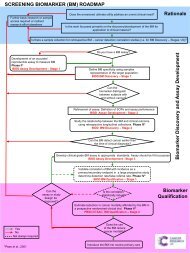
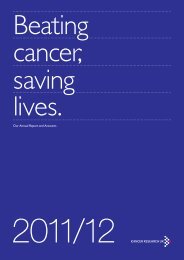
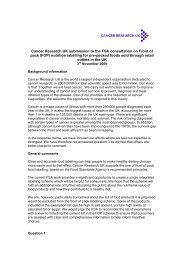
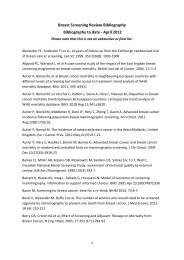
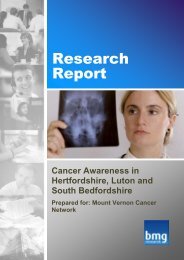
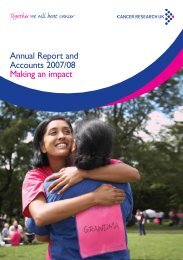
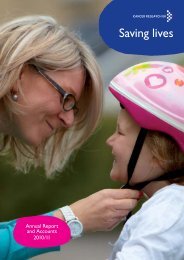
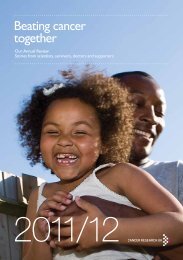

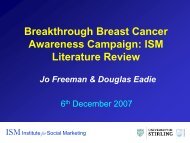
![[PDF] Cancer Research UK's strategy 2009 - 2014](https://img.yumpu.com/29239422/1/184x260/pdf-cancer-research-uks-strategy-2009-2014.jpg?quality=85)
